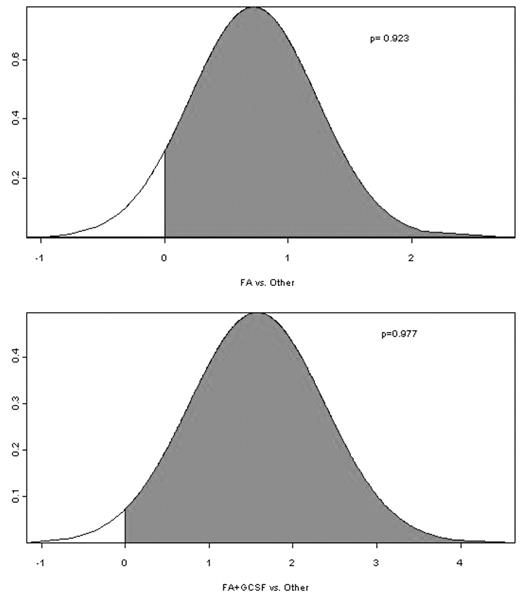Abstract
Previously (
Blood2001;98:3575–3583
) we reported that pts with inv (16) or t(8;21) (CBF) seemed to benefit from receiving fludarabine + ara-C (FA) rather than idarubicin + ara-C (IA), although other groups did not. Ara-C doses were 2g/m2 daily X 4–5 with FA and 1.5g/m2 daily X 2–4 by continuous infusion with IA. Because this observation was based on only 14 CBF pts given FA we proceeded, from 2000-present, to give all CBF pts FA either with (2000–2002; 22 pts) or without G-CSF (2003-present; 45 pts) on the days when FA was administered. Idarubicin(12 mg/m2 daily X 3) was given only if pts presented with WBC > 50,000, forcing start of treatment before cytogenetic results were known; once CR was achieved and CBF status was known, pts received 6 courses of post-remission therapy with FA (or FA +GCSF, FLAG) as described above. Median age was 41.5 years (range 16–83), 61 were male, 16 patients had antecedent hematologic disorder (AHD), 96 patients had ECOG performance status (PS) ≤ 1. One hundred and six patients (93%) achieved complete remission (CR). Events were defined as death, failure or relapse. Median time to event was 91 weeks and estimated EFS at 10 years was approximately 40%. Event-free survival (EFS) was compared in the 67 pts treated with FA or FLAG with EFS in 47 pts treated with IA +/− GCSF (IA/IAG). Because IA/IAG was given to CBF pts from 1991–2000 and FA or FLAG from 2000-present, we compared covariate-adjusted EFS in 436 pts with cytogenetics other than CBF according to whether they received IA before or after 2000 to estimate “period-effect”.EFS was superior in the earlier period, and this difference, seeming to inherently favor IA/IAG rather than FA or FLAG, was accounted for in the comparisons of these treatments in the CBF group. Preliminary analyses suggested that EFS in CBF pts was similar between IA and IAG (these groups were considered together for subsequent analyses) and longer with FLAG than with FA or IA/IAG (p= 0.06). After adjustments for covariates (age, WBC,platelets, marrow blasts etc) we compared EFS with FA, FLAG ,and IA/IAG, using both standard (Cox regression) and Bayesian approaches. The Bayesian model indicated that the posterior probability that FLAG was superior to IA/IAG was 0.98, and that, among pts given FA, the posterior probability that FLAG was superior to FA was 0.91. The Cox model indicated that the risk of an event with FLAG relative to IA/IAG was 0.84 (p = 0.07). A possible explanation for the seeming superiority of FLAG is the ability of G to increase accumulation of fludarabine-triphosphate in blasts during therapy (Clin Cancer Res1995; 1:169–178
).Disclosure: No relevant conflicts of interest to declare.
Author notes
*
Corresponding author
2006, The American Society of Hematology
2006



